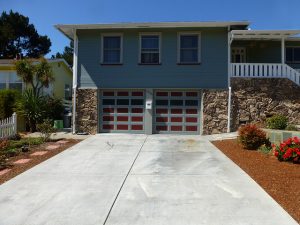
Your garage’s concrete floor takes a real beating in life. Think about it – when was the last time you swept it, scrubbed the oil stains, or gave the whole thing a good power washing? If you never cleaned or cared for your kitchen floor, you can bet it’d look pretty nasty and falling apart.
Any concrete floor surface will crack eventually; over time, things move. And especially so when we’re talking about Sacramento’s proximity to an active tectonic plate! Anyway. Cracks can be unsightly, let water or living things intrude, and even compromise the function of your garage door.
If you’ve noticed your garage door can’t fully seal at the bottom because one side of a crack is raised, or you’re staring down a new garage door installation and your concrete floor is anything but flat and prepped for an installation, you need to correct it ASAP. And what’s more fun than a garage home repair you can do yourself? Not a lot – we love that stuff.
You don’t have to do a full skim, or worse, a rip-up and repour if you’re looking at typical step cracks. You can easily fix the issue yourself in a day or two, and then your garage door will have the space it needs to actually do its job well.
How to Fill Cracks in Your Garage Floor’s Concrete
Not to say these tips only work for garage floors. You can use this guide for anything – your back patio, basement floor, driveway…
Okay, let’s get started.
1. Prepare the surface.
The first step is to clean the damaged area of the concrete floor. Remove any dirt, debris, or oil spills. You can use a broom, a pressure washer, or a solvent to clean the area. If you’ve got ground-in stains, definitely go in there with a solvent like a mapei acid etch. This is one of the mildest ones, and is much safer than higher-concentrated types.
Once you’re done, rinse/power wash the area again. After, wait until the area is dry. This may take a few hours, as water sinks into unsealed concrete.
2. Mix the repair compound.
Once the area is clean and dry, you need to mix the repair compound. There are a variety of concrete repair compounds available, so follow the instructions on the package. We are a fan of vinyl-based concrete repair putty, because not only do you not have to mix it (which everyone knows is the worst part of concrete), but it retains a miniscule amount of flexibility. That makes it less likely to open up back into a crack after application and curing.
3. Apply the repair compound.
Use a trowel or a putty knife to apply the repair compound to the damaged area. Make sure to smooth out the compound so that it is flush with the surrounding. Feather out the edges more than you think you should; when it dries, you’ll be able to feel and see surface differences much more than when it’s freshly applied.
4. Let the compound cure.
The repair compound will need time to cure. Follow the instructions on the package for the curing time. And then give it a little more. Remember to add time to cure if it’s chilly, wet, or very hot and humid; these products have a specific temperature range they need to cure correctly. It may need a bit more time if conditions aren’t right.
5. Seal the repair.
Once the repair compound has fully cured, you should use a concrete seal on the area to protect it from future damage. Make sure you seal out to the edges of wherever you used acid etch, if you chose to use it.
Final Tips for Making Your Garage’s Concrete Floor Good as New
Here are some additional tips to make sure your DIY crack repair is professional quality:
- Use a high-quality concrete repair compound. Do your research before you choose one – YouTube is a great resource for virtual demos.
- Apply the repair compound in thin layers. A thick layer of repair compound may not cure properly and is more likely to pull away from the surrounding concrete over time.
- Let the repair compound cure completely before using the garage floor. This is one project you can’t rush your way through – curing at every step, even the final one, is key to a successful crack repair.
- Seal, seal, seal. Don’t skip this step unless you want to redo this repair every year. A solid sealant (again – left to cure properly) is going to protect the floor from future damage.
See? No need to call a contractor to jackhammer your whole garage floor away and repour it. Save yourself a tonne of money by spending a bit of time fixing the cracks yourself. And after you’re finished, if you’re not really feeling the look, you’ve always got options for concrete floor paint and epoxy. Check out these epoxy finishing products. And, of course, you can always call SACS for a bit of advice!
